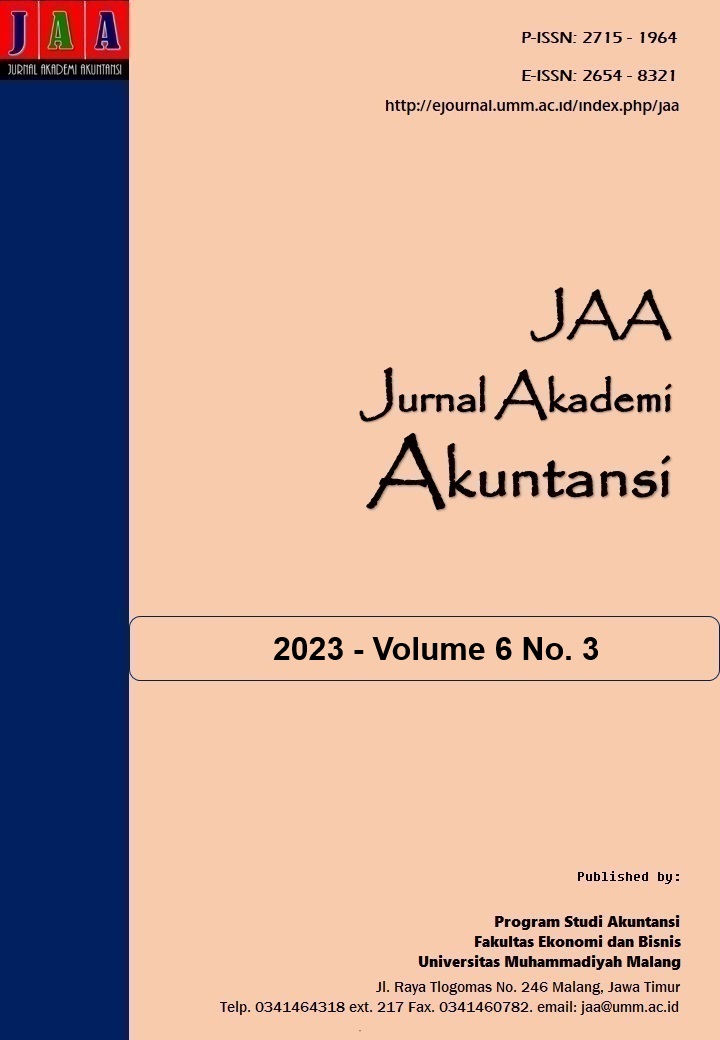Faktor dan Rencana Aksi Implementasi BCMS Pada Sektor Publik: Studi Kasus Pada Sekretariat Utama BPKP
DOI:
https://doi.org/10.22219/jaa.v6i3.27089Keywords:
Business Continuity Management System, Disruption, Incident Management, Public Sector, Risk ManagementAbstract
Purpose: Business Continuity Management System (BCMS) is not widely implemented in Indonesian public sector, therefore his study aims to reveal the drivers of BCMS implementation at the public sector and preparation that organization should done for BCMS implementation as required by the ISO 22301:2019 standard. The object of the study is Chief Secretariat of Badan Pengawasan Keuangan dan Pembangunan (BPKP) which has supporting function for government’s internal audit as BPKP core-business.
Methodology/Approach: The research done with case study method with qualitative approach. The primary data in the study was collected through semi-structured interview with people from risk management unit, incidents management unit, and IT management unit. The data analysis carried out with the benchmarking the drivers of BCMS implementation with previous study and literature and benchmarking the organizaiton existing condition with BCMS requirements.
Findings: The study found that there are urgency and need for BCMS implementation in the organization, with the main drivers are informal top-management support, uneven continuity practices, and the increase of organization’s dependency of information technology.
Practical and Theoretical Contribution/Originality: Organization need to create the BCMS policy, enhance the competency and awareness about BCMS, and update the incident response procedure as the preparations of BCMS implementation. This research contributing for future public sector implementation of BCMS.
Downloads
References
Abu Bakar, Z., Yaacob, N. A., & Udin, Z. M. (2015). International Journal of Economics and Financial Issues The Effect of Business Continuity Management Factors on Organizational Performance: A Conceptual Framework. International Journal of Economics and Financial Issues, 5, 10–11. http:www.econjournals.com
Abu Bakar, Z., Yaacob, N. A., Udin, Z. M., Hanaysha, J. R., & Loon, L. K. (2019). Business Continuity Management Implementation In The Malaysian Public Sector. In International Journal of Business and Technology Management (Vol. 1, Issue 1). http://myjms.mohe.gov.my/index.php/ijbtm
Aleksandrova, M., Balasko, S., Kaltenborn, M., Malerba, D., Mucke, P., Neuschäfer, O., Radtke, K., Prütz, R., Strupat, C., Weller, D., & Wiebe, N. (2021). WorldRiskReport 2021 Focus: Social Protection. https://reliefweb.int/attachments/8629d457-6584-3f5f-93d2-beeb20aae083/2021-world-risk-report.pdf
Chow, W., & Ha, W. (2009). Determinants of the critical success factor of disaster recovery planning for information systems. Inf. Manag. Comput. Security, 17, 248–275. https://doi.org/10.1108/09685220910978103
Chow, W. S. (2000). Success factors for IS disaster recovery planning in Hong Kong. Information Management & Computer Security, 8(2), 80–87. https://doi.org/10.1108/09685220010321326
Ellet, W. (2018). The case study handbook : a student’s guide / William Ellet. In The case study handbook : a student’s guide (Revised edition.). Harvard Business Review Press.
Everest, D., Garber, R. E., Keating, M., & Peterson, B. (2008). Global Technology Audit Guide: Business Continuity Management. The Institute of Internal Auditors. www.theiia.org/technology
Herbane, B., Elliott, D., & Swartz, E. M. (2004). Business Continuity Management: Time for a strategic role? Long Range Planning: International Journal of Strategic Management, 37, 435–457. https://doi.org/10.1016/j.lrp.2004.07.010
Hoong, L. L., & Marthandan, G. (2011). Factors influencing the success of the disaster recovery planning process: A conceptual paper. 2011 International Conference on Research and Innovation in Information Systems, 1–6.
Hussain, S. T., Lei, S., Akram, T., Haider, M. J., Hussain, S. H., & Ali, M. (2018). Kurt Lewin’s change model: A critical review of the role of leadership and employee involvement in organizational change. Journal of Innovation and Knowledge, 3(3), 123–127. https://doi.org/10.1016/j.jik.2016.07.002
International Organization for Standardization. (2019). Security and resilience — Business continuity management systems — Requirements (ISO Standard No.22301:2019). International Organization for Standardization. https://www.iso.org/standard/75106.html
International Organization for Standardization. (2020). Security and resilience — Business continuity management systems —Guidance on the use of ISO 22301 (ISO Standard No.22313:2020). https://www.iso.org/standard/75107.html
Järveläinen, J. (2013). IT incidents and business impacts: Validating a framework for continuity management in information systems. International Journal of Information Management, 33(3), 583–590. https://doi.org/10.1016/J.IJINFOMGT.2013.03.001
Krell, E., Accountants, A. I. of C. P., & Canada, S. of M. A. of. (2006). Business Continuity Management: Strategy. CMA Canada. https://www.cimaglobal.com/Documents/ImportedDocuments/Tech_mag_business_continuity_sept06.pdf
Lewin, K. (1951). Field theory in social science: selected theoretical papers (Edited by Dorwin Cartwright.). In Field theory in social science: selected theoretical papers (Edited by Dorwin Cartwright.). Harpers.
Mitroff, I. (2005). Why Some Companies Emerge Stronger and Better from a Crisis: 7 Essential Lessons for Surviving Disaster. Amacom.
Nugroho, S. P. (2015). Population Exposed to Natural Hazards: a Study Based on the 2010 Population Census (A. Wibowo, I. M. Surbakti, A. A. Lomban, A. Hermawan, T. Harjito, D. Handiyatmo, D. Oktiari, Nuraini, & N. Pramudhiarta, Eds.). https://indonesia.unfpa.org/sites/default/files/pub-pdf/Population_Exposed_0.pdf
Payne, C. F. (1999). Contingency plan exercises. Disaster Prevention and Management, 8, 111–117.
Pitt, M., & Goyal, S. (2004). Business continuity planning as a facilities management tool. Facilities, 22(3/4), 87–99. https://doi.org/10.1108/02632770410527824
Saunders, M., Lewis, P., & Thornhill, A. (2019). Research Methods for Business Students. Pearson.
Segovia, F. (2017). Developing a Framework for Business Continuity Management within Local Developing a Framework for Business Continuity Management within Local Government Government. https://ro.uow.edu.au/theses1
Sunil Rai, B., Director, J., Jain, S. P., & Mohan, L. (2006). Business Continuity Model: A Reality Check for Banks in India. In Journal of Internet Banking and Commerce (Vol. 11, Issue 2). http://www.arraydev.com/commerce/jibc/
Triyani, A., & Setyahuni, S. W. (2023). How Financial Distress Affect The Coping Strategy? Case Of Indonesian MSME’s During The Covid-19 Outbreak. Jurnal Reviu Akuntansi Dan Keuangan, 13(1), 1–17. https://doi.org/10.22219/jrak.v13i1.22209
Yin, R. K. (2017). Case Study Research and Applications: Design and Methods. SAGE Publications.
Downloads
Published
Issue
Section
License
Copyright (c) 2023 Bambang Satria A Wibowo, Ancella Hermawan

This work is licensed under a Creative Commons Attribution-NonCommercial-ShareAlike 4.0 International License.
Jurnal Akademi Akuntansi is licensed under a Creative Commons Attribution-NonCommercial-ShareAlike 4.0 International License.
Authors who publish with this journal agree to the following terms:
- Authors retain copyright and grant the journal right of first publication with the work simultaneously licensed under a Creative Commons Attribution-NonCommercial-ShareAlike 4.0 International License that allows others to share the work with an acknowledgment of the work's authorship and initial publication in this journal.
- Authors are able to enter into separate, additional contractual arrangements for the non-exclusive distribution of the journal's published version of the work (e.g., post it to an institutional repository or publish it in a book), with an acknowledgment of its initial publication in this journal.
- Authors are permitted and encouraged to post their work online (e.g., in institutional repositories or on their website) prior to and during the submission process, as it can lead to productive exchanges, as well as earlier and greater citation of published work (See The Effect of Open Access).
Jurnal Akademi Akuntansi dilisensikan di bawah lisensi Creative Commons Attribution-NonCommercial-ShareAlike 4.0 International.
Penulis yang menerbitkan artikel di jurnal ini menyetujui ketentuan berikut:
- Penulis mempertahankan hak cipta dan memberikan hak jurnal atas publikasi pertama dengan karya yang secara serentak dilisensikan di bawah Lisensi Pengaitan Creative Commons yang memungkinkan orang lain untuk berbagi karya dengan pengakuan atas karya penulis dan publikasi awal dalam jurnal ini.
- Penulis dapat masuk ke dalam pengaturan kontrak tambahan yang terpisah untuk distribusi non-eksklusif versi karya jurnal yang diterbitkan (misalnya, mempostingnya ke repositori institusional atau mempublikasikannya dalam sebuah buku), dengan pengakuan publikasi awalnya di jurnal ini.
- Penulis diizinkan dan didorong untuk memposting pekerjaan mereka secara online (misalnya, di repositori institusional atau di situs web mereka) sebelum dan selama proses pengajuan, karena dapat mengarah pada pertukaran produktif, serta kutipan pekerjaan sebelumnya dan yang lebih besar (Lihat Pengaruh Akses Terbuka).
























